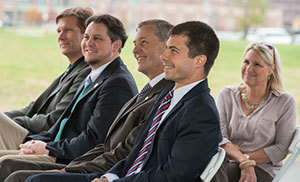
Groundbreaking ceremonies were held Wednesday (Oct. 15) for two multitenant office buildings at South Bend’s Ignition Park, which will include space for the University of Notre Dame’s new Turbomachinery Facility.
The University and five public and private partners announced a $36 million project in June that will be the nation’s foremost research and test facility for advancing the technology used in the massive gas turbine engines used by commercial and military aircraft, power plants and the oil and gas industries.
Great Lakes Capital will initially construct two buildings at the proposed Ignition Park campus with a minimum guaranteed investment of $12 million, providing 86,000 square feet of space. The Turbomachinery Facility will occupy approximately 43,000 square feet of space and will be fully operational by July 2016.
South Bend Mayor Peter Buttigieg, Notre Dame Executive Vice President John Affleck-Graves and Brad Toothaker, managing partner of the Great Lakes Capital family of companies, offered remarks at the groundbreaking.
In addition to the City of South Bend and Great Lakes Capital, Notre Dame’s partners in the Turbomachinery Facility include General Electric Co., the state of Indiana and Indiana Michigan Power. It also will be used to advance current working relationships with both government sponsors and all manufacturers of gas turbine engines.
Notre Dame’s current Turbomachinery Laboratory has worked with industry and government partners to advance gas turbine engine technologies since 2003. Center researchers focus on the design and operation of test facilities that simulate full-scale engine operating environments.
The new facility, which will feature five test bays for compressor and turbine rig testing, will take previous work to new heights by testing engine components at pressures and temperatures higher than any that exist at current U.S. university facilities.
Originally published by at news.nd.edu on October 15, 2014.